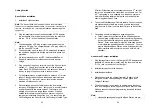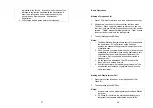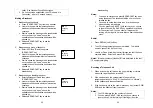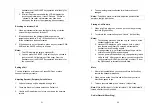
53
Technical Specifications
Electrical Specifications
Base Station
Portable Handset
Frequency 902-928 MHz
902-928 MHz
RF Power Peak: 708 mW
Average: 304 mW
Peak: 708 mW
Average: 76 mW
Channel Spacing 200 kHz
200 kHz
Number of Channels 50
50
Modulation MSK
MSK
Multiple Access Frequency Hopping TDMA
Frequency Hopping TDMA
Frequency Hopping
Rate
100 per second
100 per second
TDMA Frame Length 10 ms
10 ms
Number of Slots/Frame 8
8
Number of
Users/Carrier
4
4
Receiver Sensitivity < -108 dBm (@ BER 10
-2
)
< -108 dBm (@ BER 10
-2
)
Antenna Connector Reverse TNC
Non-standard
Antenna Gain 2 dBi
0 dBi
TX Power Control
Range
NA
100-708 mW
Telephone Interface RJ11 x 4
NA
Speech Coding 8 kbps G.729A
8 kbps G.729A
Channel Coding 8 kbps Convolu
CRC
8 kbps Convolu
CRC
Transmission Data Rate 170.678 kbps
176.678 kbps
User Data Rate 128 kbps duplex
128 kbps duplex
Duplex Time Division Duplex
(TDD)
Time Division Duplex
(TDD)
Voice Quality TIA/EIA-470B
TIA/EIA-470B
No. of System ID 65,536
65,536
Ring Signal 20-50 Hz, 12-90 Vrms
NA
Auto-Attendant Coding 8 kbps G.729
8 kbps G.729
Flash Time 100-900 ms
programmable
NA
Power Source 120V/7V AC/DC Adapter
4.8 V, 750 mAh NiMH
Charger Current NA
500 mA
Charge Time NA
90 minutes (from empty)
Regulation Compliance FCC Part 15, Part 68
CAN/DOC RSS210, CS03
FCC Part 15, Part 68
CAN/DOC RSS210, CS03
Hearing Aid Compatible
Operating Temperature -10 – 60
°
C
-10 – 60
°
C
Storage Temperature -10 – 70
°
C
-10 – 70
°
C
Humidity 20 – 75 %
20 – 75 %
Dimension without
antenna
280 x 215 x 53 mm
8.5” x 11.0” x 2.1”
150 x 50 x 34 mm
2.0” x 5.9” x 1.3”
Weight 32 ounces
8.25 ounces
Notes:
1. NA = Not Applicable.
2. The manufacturer reserves the right to change designs
and specifications without notice.
54
Federal Communication Commission Interference Statement
This equipment has been tested and found to comply with the
limits for a Class B digital device, pursuant to Part 15 of the FCC
Rules. These limits are designed to provide reasonable protection
against harmful interference in a residential installation. This
equipment generates, uses and can radiate radio frequency
energy and, if not installed and used in accordance with the
instructions, may cause harmful interference to radio
communications. However, there is no guarantee that interference
will not occur in a particular installation. If this equipment does
cause harmful interference to radio or television reception, which
can be determined by turning the equipment off and on, the user is
encouraged to try to correct the interference by one of the
following measures:
- Reorient or relocate the receiving antenna.
- Increase the separation between the equipment and receiver.
- Connect the equipment into an outlet on a circuit different from
that to which the receiver is connected.
- Consult the dealer or an experienced radio/TV technician for help.
This device complies with Part 15 of the FCC Rules. Operation is
subject to the following two conditions: (1) This device may not
cause harmful interference, and (2) this device must accept any
interference receive d, including interference that
may cause undesired operation.
FCC Caution: Any changes or modifications not expressly
approved by the party responsible for compliance could void the
user's authority to operate this equipment.
IMPORTANT NOTE: FCC Radiation Exposure Statement:
The Base Unit complies with FCC radiation exposure limits set
forth for an uncontrolled environment. This equipment should be
installed and operated with minimum distance 20cm between the
radiator & your body. To maintain compliance with FCC RF
exposure compliance requirements.
Body-worn Operation
This device was tested for typical body-worn operations. To
comply with RF exposure requirements, a minimum separation
distance of 1.5 cm must be maintained between the user
⋯
s body
and the handset, including the antenna. Third-party belt-clips,
holsters, and similar accessories used by this device should not
contain any metallic components. Body-worn accessories that do


































